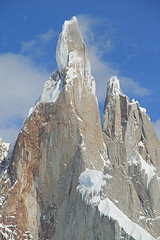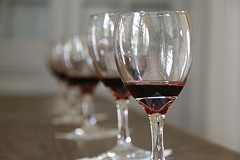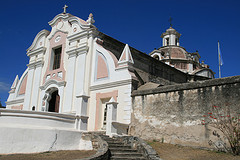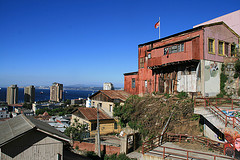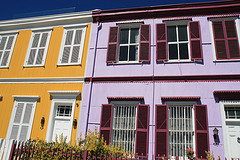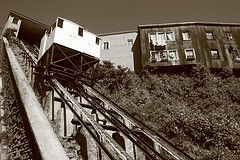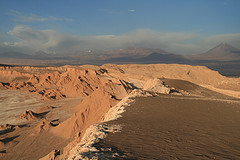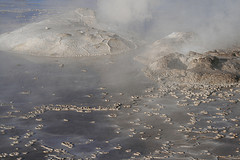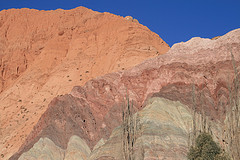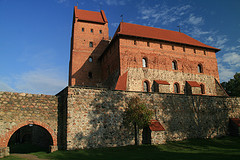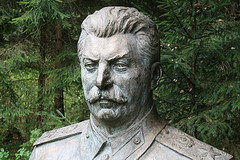Trekking in Torres del Paine
December 15th, 2009After nine days of trekking/camping in Torres del Paine National Park, we returned to Puerto Natales yesterday, enjoyed a deserved bottle of wine and enormous hamburguesas completas last night, and reflected on a fantastic trip. I won’t go into a day-by-day rundown of how it went down, but will instead list a few highlights below:
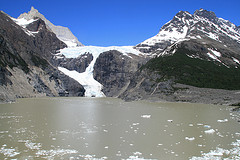 The Back Trail: We opted to do the full circuit rather than the abbreviated ‘W’, and were really glad we did, both because of the scenery on the back trail that, while not as famous as the must-see places on the W, was still quite stunning, and the lack of crowds (on the third day, for example, we did not see a single other person during the four-hour hike from one camp to another). Visual highlights of the back trail were the Dickson and Perros glaciers, the forest walk on Day 3, numerous picturesque lakes and trudging through the mud and snow to reach the John Garner pass on Day 4.
The Back Trail: We opted to do the full circuit rather than the abbreviated ‘W’, and were really glad we did, both because of the scenery on the back trail that, while not as famous as the must-see places on the W, was still quite stunning, and the lack of crowds (on the third day, for example, we did not see a single other person during the four-hour hike from one camp to another). Visual highlights of the back trail were the Dickson and Perros glaciers, the forest walk on Day 3, numerous picturesque lakes and trudging through the mud and snow to reach the John Garner pass on Day 4.
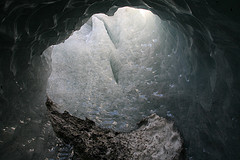 Being Inside a Glacier: On Day 3 we arrived at camp pretty early and one of the campsite staff recommended a one-hour side trip to the Glacier Puma, which we’d never heard of. Six of us went together and although the glacier was not nearly as beautiful as Grey, Perito Moreno etc, it offered something completely different that made it especially memorable: an ice tunnel that we could walk into, putting ourselves inside the glacier, surrounded by bubble-filled ice on three sides, with a glacial stream running along the ground and a vertical shaft leading up to the blue sky above. It’s hard to describe how awesome that was.
Being Inside a Glacier: On Day 3 we arrived at camp pretty early and one of the campsite staff recommended a one-hour side trip to the Glacier Puma, which we’d never heard of. Six of us went together and although the glacier was not nearly as beautiful as Grey, Perito Moreno etc, it offered something completely different that made it especially memorable: an ice tunnel that we could walk into, putting ourselves inside the glacier, surrounded by bubble-filled ice on three sides, with a glacial stream running along the ground and a vertical shaft leading up to the blue sky above. It’s hard to describe how awesome that was.
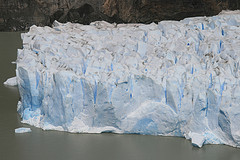 Glacier Grey: After trekking slowly through mud and snow to the 1241m John Garner pass on Day 4, we caught our first view of the glacier that would dominate the trail for the next two days as we walked above it. Glacier Grey is enormous and as we sat on top of the pass (the best place to appreciate its vastness), it stretched far away in all directions, and we were even able to see part of the 350km long Southern Patagonian Ice Field (the Hielo Sur) to the north. On Day 5 we were lucky to catch a rainbow shining over the glacier and when we finally reached the ‘snout’ later that day it was almost as beautiful as Perito Moreno, which is not something you say lightly.
Glacier Grey: After trekking slowly through mud and snow to the 1241m John Garner pass on Day 4, we caught our first view of the glacier that would dominate the trail for the next two days as we walked above it. Glacier Grey is enormous and as we sat on top of the pass (the best place to appreciate its vastness), it stretched far away in all directions, and we were even able to see part of the 350km long Southern Patagonian Ice Field (the Hielo Sur) to the north. On Day 5 we were lucky to catch a rainbow shining over the glacier and when we finally reached the ‘snout’ later that day it was almost as beautiful as Perito Moreno, which is not something you say lightly.
Hot Showers on Days 5 & 7: ‘Nuff said.
The Social Trail: Before we started hiking, we figured we’d spend most of our camp time huddled up in our tent trying to stay warm. But we made friends on the first day and the social aspect turned out to be one of the most enjoyable things about the hike. Our new hiking buddies ranged from married Canadian veterinarians to an American father-daughter combo (he admirably hiked the entire circuit at age 70) to a Belgian-Israeli pseudo-couple. But most of all we befriended a well-hiked New York history teacher named Darin, who followed the same itinerary as us for nine days and will now be a friend for life (or at least a friend in Ushuaia later this week…).
The Complete Absence of Wind: All we’d heard before visiting the park was that it would be the windiest experience of our lives and that we would return with all sorts of crazy wind-related stories (as long as we were lucky enough to actually survive the trek instead of being blown off the side of a mountain). And for the first half-an-hour or so after we got off the bus, it seemed like everything we’d heard would be true. But then a funny thing happened: the wind died down, and basically didn’t blow again for the next nine days. Compared with El Chaltén, Torres del Paine was a paradigm of stillness.
And, finally, the unfortunate disappointment of the trek:
The Torres del Paine: At sunrise on clear days, the four towers that make up the Torres del Paine and give the park its name are bathed in red in spectacular fashion. So, at 3:45am yesterday we duly woke up, rolled out of our tents at the Campamento Torres and trudged for 45 minutes in the dark and drizzle up to the look out point at the base of the towers. But to our great disappointment the granite peaks were almost completely shrouded in mist and there was no red light to be seen. Cold, wet, tired and pretty miserable, we walked back down once ‘sunrise’ had passed and went back to sleep in our tents. In the meantime, the sun came out, the fog cleared and Darin, who had stayed at the viewpoint despite the conditions, ended up with some great views and photos of the towers, albeit not red ones. It wasn’t the finish to the trek that we’d hoped for, and we considered staying an extra day to try again for the sunrise views, but in the end we decided that eight nights was enough, and we headed back down and out of the park.
Today is a scheduled rest day in Puerto Natales, but fortunately we are not as sore as we feared we would be. Tomorrow we continue our journey south by crossing the Straits of Magellan to the Tierra del Fuego and onto Ushuaia, the world’s southern-most city.


